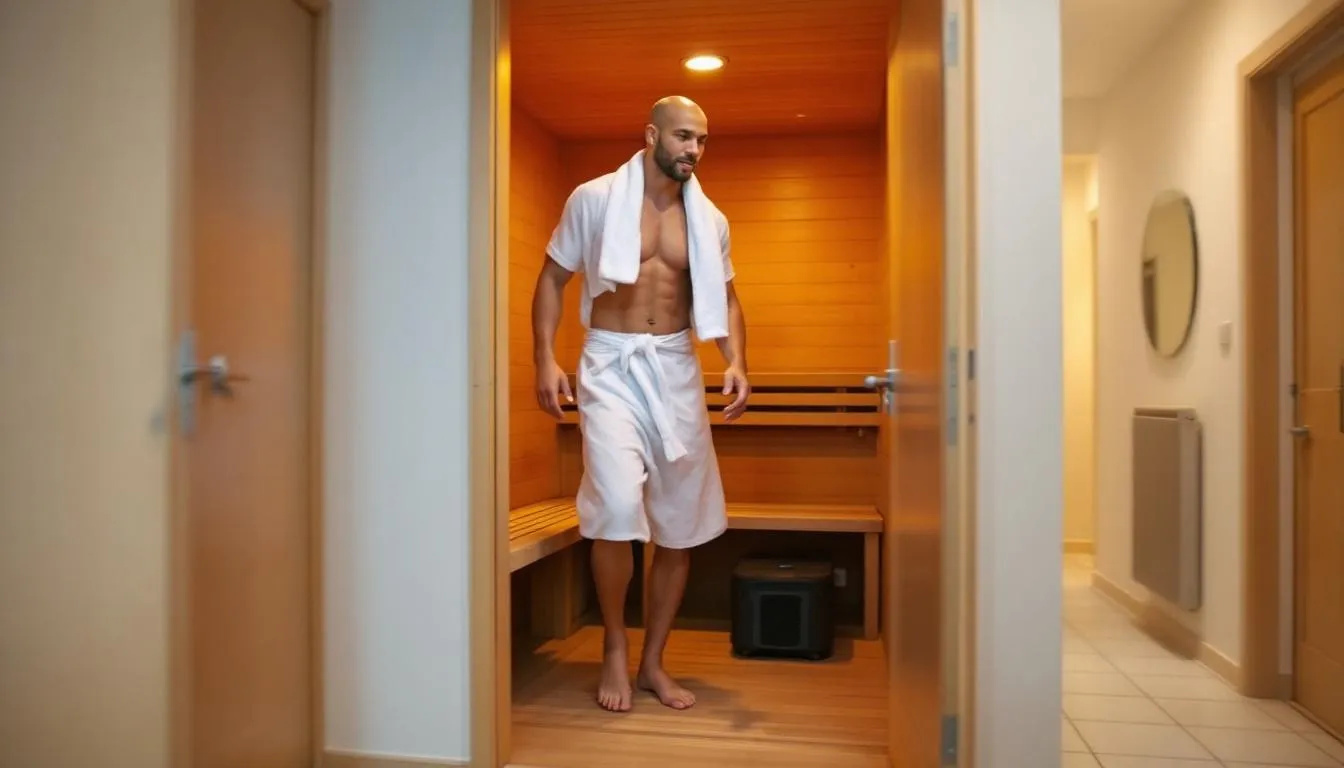Understanding the electrical requirements for a home sauna installation is crucial for safety and efficiency. This includes knowing the correct voltage, amperage, and the need for dedicated circuits.
Consulting a licensed electrician is essential to meet these requirements. This guide will walk you through everything you need to ensure a safe and effective sauna setup.
Whether you're installing the best outdoor sauna for a modern home or just a traditional model, proper electrical planning is the foundation of a successful project.
Key Takeaways
• A dedicated circuit is essential for sauna heaters, preventing overloads and ensuring safe operation.
• Selecting the appropriate heater size based on sauna dimensions is crucial for efficient heating and user comfort.
• Hiring a licensed electrician for installation and ensuring code compliance are critical for the safety and effectiveness of the sauna's electrical system.
What Are the Electrical Needs for Your Home Sauna?
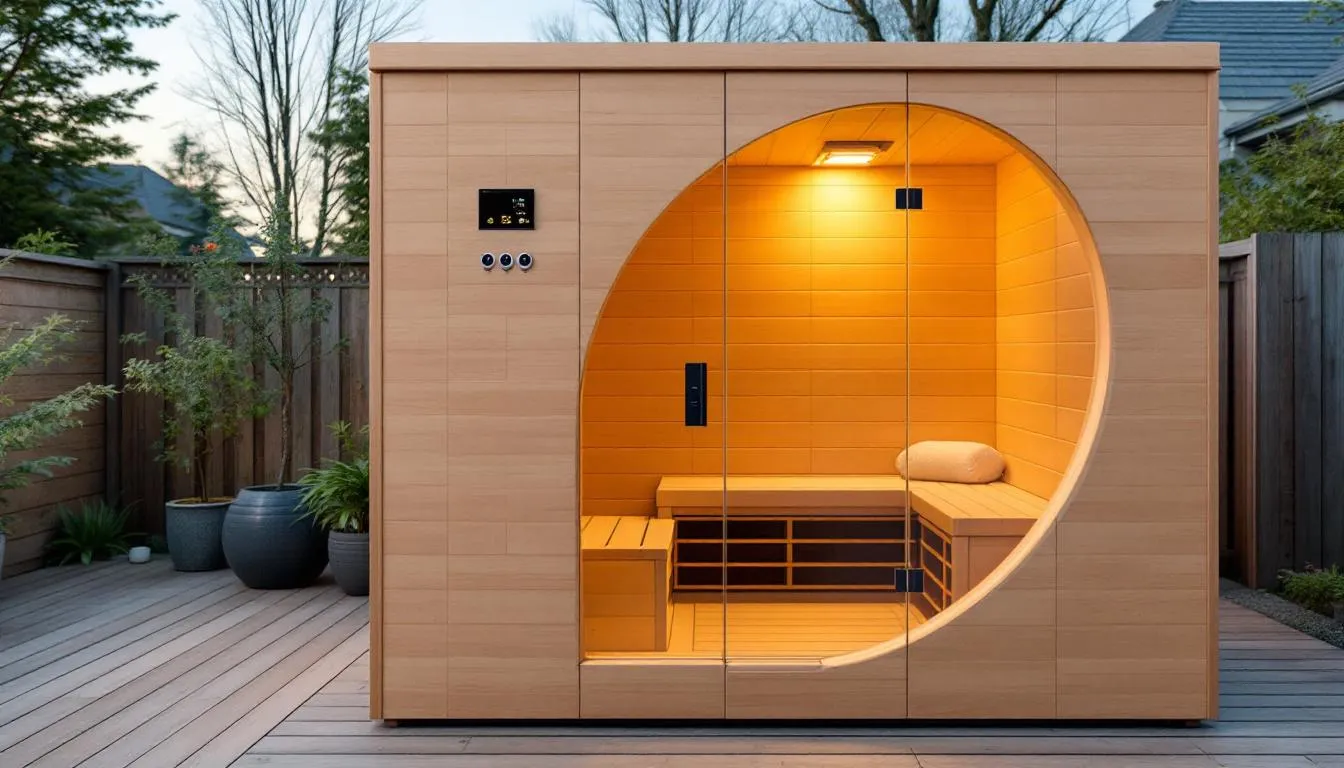
Setting up the electrical components of a home sauna involves more than just plugging in a heater. The entire process requires careful planning to ensure safety and efficiency.
Key components such as heaters and control panels require a dedicated electrical service to perform optimally. Understanding these needs is the first step towards a successful home infrared sauna installation.
Safety and efficiency are paramount when dealing with sauna electrical requirements. Proper planning and adherence to safety measures can help prevent common electrical hazards, such as overloads and fire risks.
This guide includes information on selecting the right heater, understanding basic wiring, installation of dedicated circuits, and selection of suitable lighting for your sauna.
Essential Components Overview
We'll cover voltage and amperage requirements, the importance of dedicated circuits, and the role of proper wiring. Each component plays a vital part in creating a safe and enjoyable sauna experience.
Whether you're setting up an infrared sauna 1-person unit or a larger model, these electrical principles apply universally. Understanding the infrared sauna price considerations alongside electrical requirements helps you budget accurately.
The complexity of electrical work varies depending on whether you choose a luxury home sauna or a more basic model.
Voltage and Amperage Requirements
Most traditional saunas operate on a 240-volt power supply, which is standard for high-power appliances. The typical voltage required for saunas is 240 volts, ensuring that the heater receives sufficient power to function effectively.
Equally important is the amperage; sauna heaters generally require a circuit breaker size ranging from 30 to 60 amps. The exact requirement depends on the size and type of the sauna.
Consult a licensed electrician to determine the specific electrical requirements for your sauna. They can provide detailed electrical information, including the appropriate breaker size and wiring needed for your setup.
Your electrical panel must handle the additional load for safe and efficient operation. This is especially important when considering a 2-3-person home sauna that requires more power.
Dedicated Circuit Necessity
A dedicated circuit is essential for sauna heaters to operate safely and efficiently. The heater should have its own circuit breaker and wiring, separate from other home electrical systems.
A dedicated circuit prevents overloads and reduces the risk of electrical fires from an overburdened system. This is a non-negotiable safety requirement for any sauna installation.
Each sauna heater requires its own dedicated circuit and breaker to manage the electrical load effectively. This setup ensures that the heater operates at peak performance without compromising the safety of your home's electrical system.
A dedicated circuit ensures a worry-free sauna experience with a safe and efficient electrical setup.
How Do You Choose the Right Electric Sauna Heater?
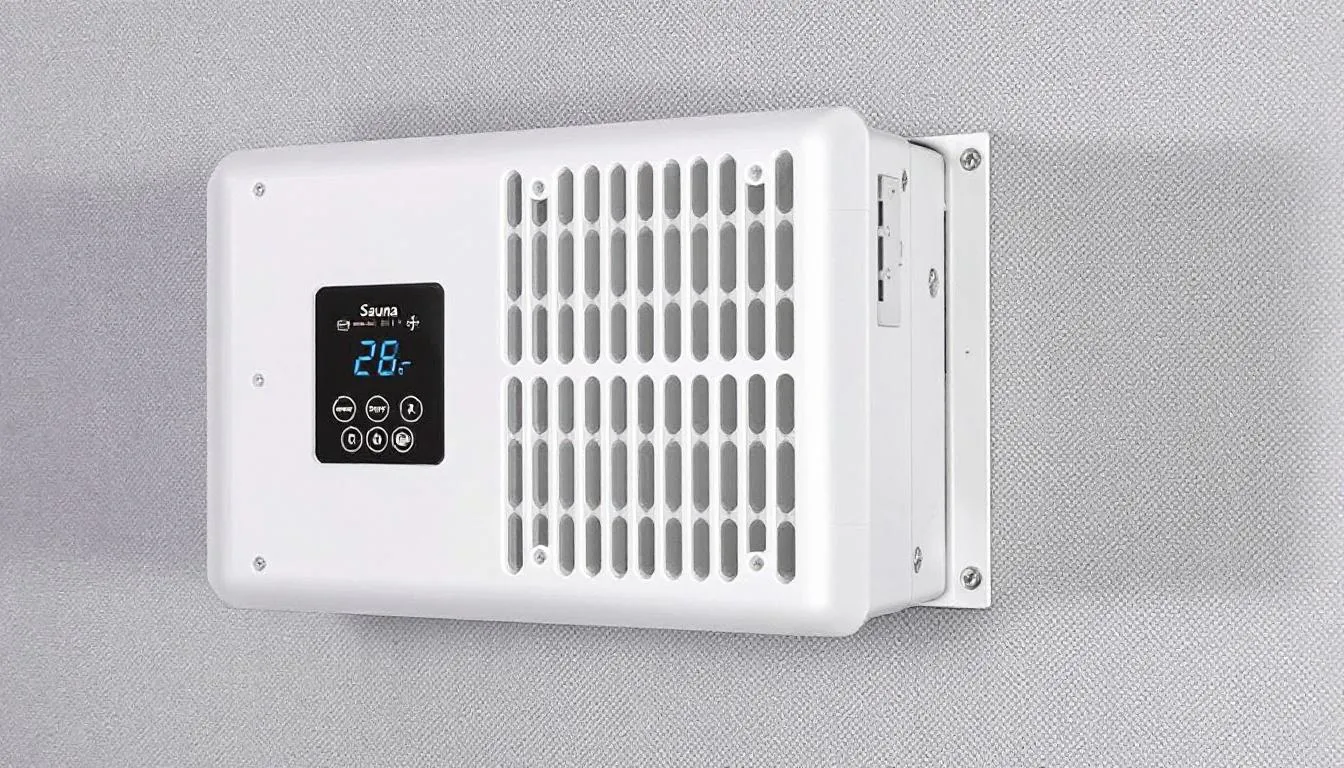
Selecting the right sauna heater is crucial for creating a comfortable and efficient sauna environment. The size and style of your sauna room will dictate the appropriate heater size needed for effective heating.
Ensuring that the heater's specifications are compatible with your sauna's power supply is also essential for optimal performance. This is particularly important when comparing options among the best home saunas.
When choosing a sauna heater, consider factors such as the size of your sauna room and the type of sauna you prefer. Understanding the infrared sauna vs traditional sauna differences is important for making the right choice.
Traditional saunas use electric heaters with heating elements to produce steam and high temperatures. Meanwhile, infrared saunas use infrared heaters that generate lower temperatures but offer a different kind of heat experience.
Both types of heaters have their benefits, so it's important to choose the one that best suits your needs. Many people wonder about infrared sauna health benefits when making their decision.
Proper power supply is vital for the installation of a sauna heater. Your electrical system must handle the heater's requirements for safe and efficient operation.
Next, we'll delve into heater sizing specifics and energy efficiency considerations.
Sizing Your Heater for Optimal Performance
Proper heater sizing is vital for effective sauna performance and energy efficiency. The general rule of thumb is to allocate 1 kilowatt (KW) of power for every 50 cubic feet of sauna space.
For example, if your sauna room is 200 cubic feet, you would need a 4 KW heater to achieve the desired temperature. This ensures that your sauna heats up quickly and maintains a consistent temperature throughout your sauna session.
For outdoor saunas without insulation, it's recommended to add 25-30% more power to compensate for the heat loss. This means you may need a larger heater if your sauna is located outside or in an uninsulated space.
Sauna heaters vary in size, requiring between 4.5 to 29 kilowatts depending on the sauna. Choosing the right heater size ensures efficient heating and prevents overheating and potential damage.
Personal comfort is another important factor to consider when sizing your heater. Some people prefer lower temperatures for a more relaxing experience, while others enjoy higher temperatures for a more intense session.
Choosing the right temperature and heater size allows you to achieve the perfect balance between comfort and efficiency. This ensures an enjoyable sauna experience every time, even in smaller saunas.
Understanding the 1-person home sauna cost helps you factor in both the initial heater investment and long-term energy expenses.
Energy Efficiency Considerations
Energy efficiency is a critical consideration when selecting a sauna heater. Infrared heaters are known to consume less energy while providing faster heating compared to traditional electric heaters.
This makes them an attractive option for those looking to reduce energy costs and enjoy quicker heating times. The infrared sauna benefits detox capabilities are enhanced when proper heating is achieved efficiently.
Lower energy consumption, quicker heating times, and efficient comfort are key benefits of infrared saunas compared to conventional electric heaters. Many users also appreciate the benefits of infrared sauna for athletes in their training routines.
Regular care and maintenance of sauna heaters also contribute significantly to energy savings. Maintaining your heater in good condition ensures efficient operation and longevity.
Utilizing energy-efficient heaters in your sauna can lead to lower operating costs and an enhanced user experience. An energy-efficient heater benefits your wallet and reduces your environmental footprint.
Discover energy-efficient options with the best infrared saunas from our curated collection featuring the latest technology.
What Are the Wiring Essentials for Safe Installation?
Proper wiring is essential to ensure safety, performance, and code compliance in sauna installations. Improper wiring can lead to fire hazards, electrical shock risks, reduced heater performance, and code violations.
A licensed electrician ensures sauna wiring is safe and compliant with local electrical codes. DIY wiring projects for saunas are strongly discouraged due to the potential dangers involved.
Wiring for sauna installations must withstand high temperatures and be of the correct gauge and type. Using the correct wire gauge ensures safety and efficiency, helping to prevent overheating risks.
THWN conductors should be used inside the conduit for moisture resistance. NM-B cable or conduit should be used for indoor sauna wiring to ensure safety.
Essential Wiring Guidelines
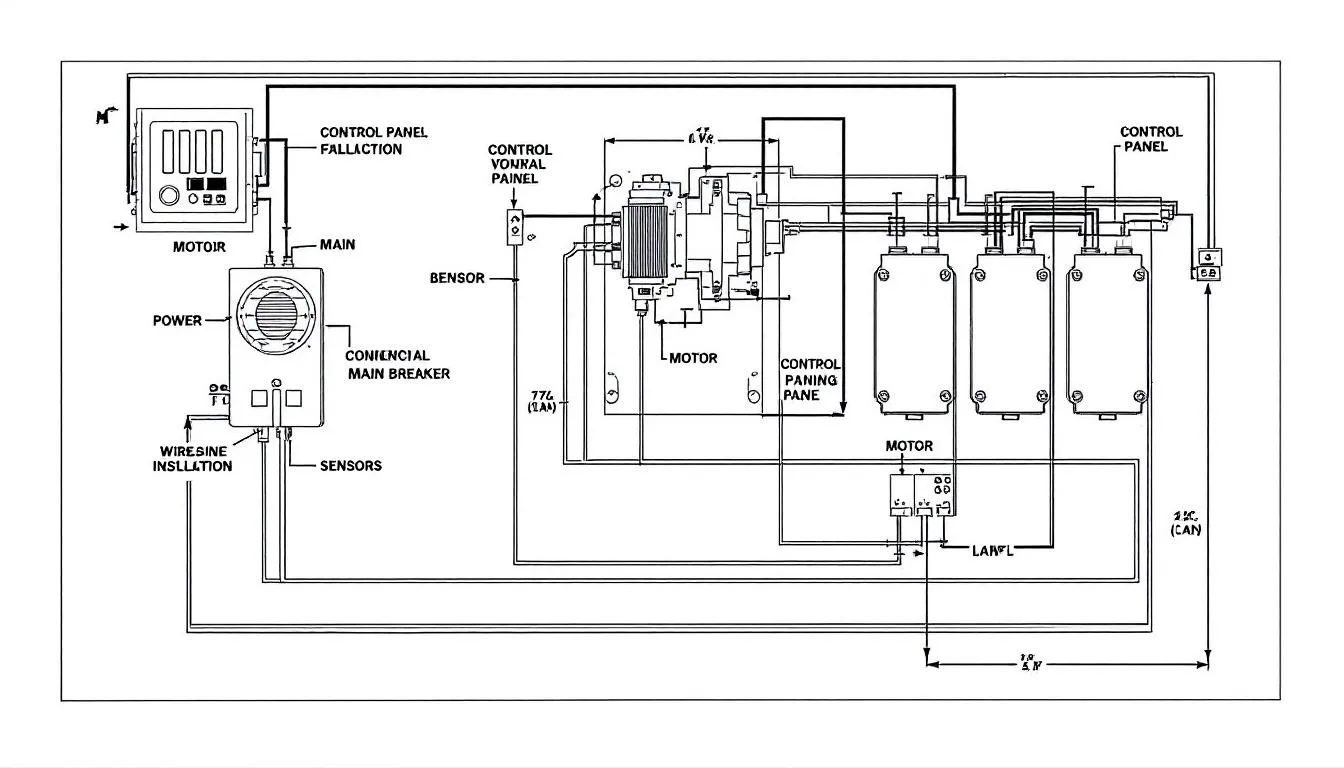
Key guidelines for wiring a sauna include grounding the heater frame to protect against electrical shorts. Mounting control panels outside or in a protected wall cavity ensures safety during operation.
Routing electrical conduit entry through a hole in the sauna wall below the heater enables proper installation. These practices are especially important for outdoor infrared sauna installations where exposure to elements is a concern.
Proper wiring practices not only ensure safety but also enhance the performance and longevity of your sauna. Whether installing a weatherproof outdoor infrared sauna or indoor model, these principles apply.
Wire Gauge and Type Specifications
The typical wire gauge required for sauna wiring ranges from #10 to #6 AWG. Selecting the correct wire gauge is crucial for preventing overheating and ensuring efficient power delivery to the heater.
For an 8.0kw sauna heater, a 40-amp breaker and 8/2 wire are required. Wiring for saunas must be rated for high temperatures to ensure safe operation.
Using the right type of wire is equally important. For moisture resistance, THWN conductors should be used inside the conduit for sauna wiring.
NM-B cable or conduit is recommended for indoor sauna wiring to ensure safety. Proper wire gauge and type selection not only ensure safety but also enhance the performance and longevity of your sauna.
These specifications are consistent whether you're installing an infrared sauna indoor 2-person model or a traditional sauna.
GFCI Protection for Enhanced Safety
GFCI protection is crucial for all sauna installations in wet or damp locations to prevent electrical shocks. GFCI stands for Ground Fault Circuit Interrupter and is designed to quickly cut off power in case of an electrical fault.
All sauna electrical setups should include GFCI protection, especially in wet or damp locations, to enhance safety. This is particularly important for any outdoor infrared sauna installation guide recommendations.
Compliance with electrical standards prevents hazards and ensures smooth operation. While GFCI protection is recommended, it is not legally required for all sauna heater installations.
However, including GFCI protection in your sauna setup adds an extra layer of safety, ensuring a worry-free sauna experience. This protection is essential regardless of whether you're setting up a home sauna for sale unit or custom-built sauna.
What Role Do Control Panels and Lighting Play?
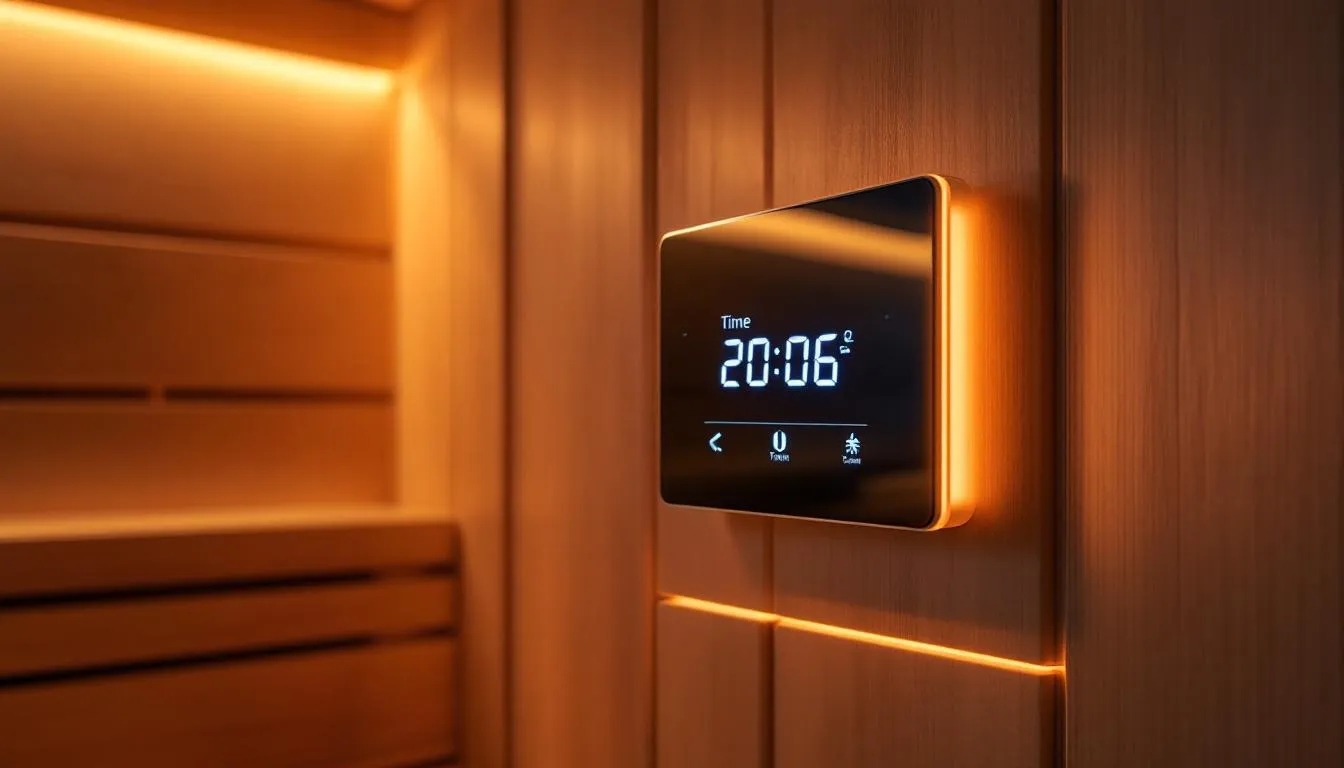
Control panels and lighting play a significant role in enhancing the user experience and safety of a sauna. Modern sauna control panels manage temperature, humidity, lighting, and session duration, ensuring a safe experience.
Control panels must allow for easy monitoring and adjustment of sauna settings to enhance user experience. This is true whether you're using a basic model or exploring sauna accessories for advanced functionality.
LED lights used in saunas should not only be moisture-resistant but also create a pleasing atmosphere. Combining effective control systems with appropriate lighting enhances user safety and creates a relaxation ambiance in the sauna.
Some users also incorporate best sauna accessories 2025 like chromotherapy lighting systems for additional wellness benefits. In the following sections, we'll delve into the specifics of selecting moisture-resistant lights and integrating smart control panels.
Selecting Moisture-Resistant Lights
Moisture-resistant lights that create the desired ambiance should be used in saunas. LED lights are favored for saunas as they generate minimal heat, making them safer in high-temperature environments.
Water-resistant properties make LED lights suitable for a sauna environment. This is especially important when considering the overall home sauna wellness experience.
Lighting fixtures in saunas need to be constructed from materials that can resist chemical reactions due to heat and humidity. Choosing the right lighting not only enhances the aesthetic appeal of your sauna but also ensures safety and durability.
LED lights are an excellent choice for their energy efficiency and long lifespan. They complement other wellness additions like an infrared sauna blanket for comprehensive home spa experiences.
Integrating Smart Control Panels
Smart control panels allow for advanced functionality and convenience in managing your sauna. Some smart control panels allow for mobile app integration, enabling users to manage their sauna remotely.
This mobile access allows for real-time adjustments to temperature and lighting settings. Users can preheat their sauna before arriving home, optimizing convenience.
Smart panels can often integrate with home automation systems to provide seamless control over sauna functions. Integration with home automation allows users to create customized sauna routines.
This adds a level of convenience and luxury to your sauna setup. Modern systems often include these advanced features as standard.
What Maintenance is Necessary for Electrical Safety?
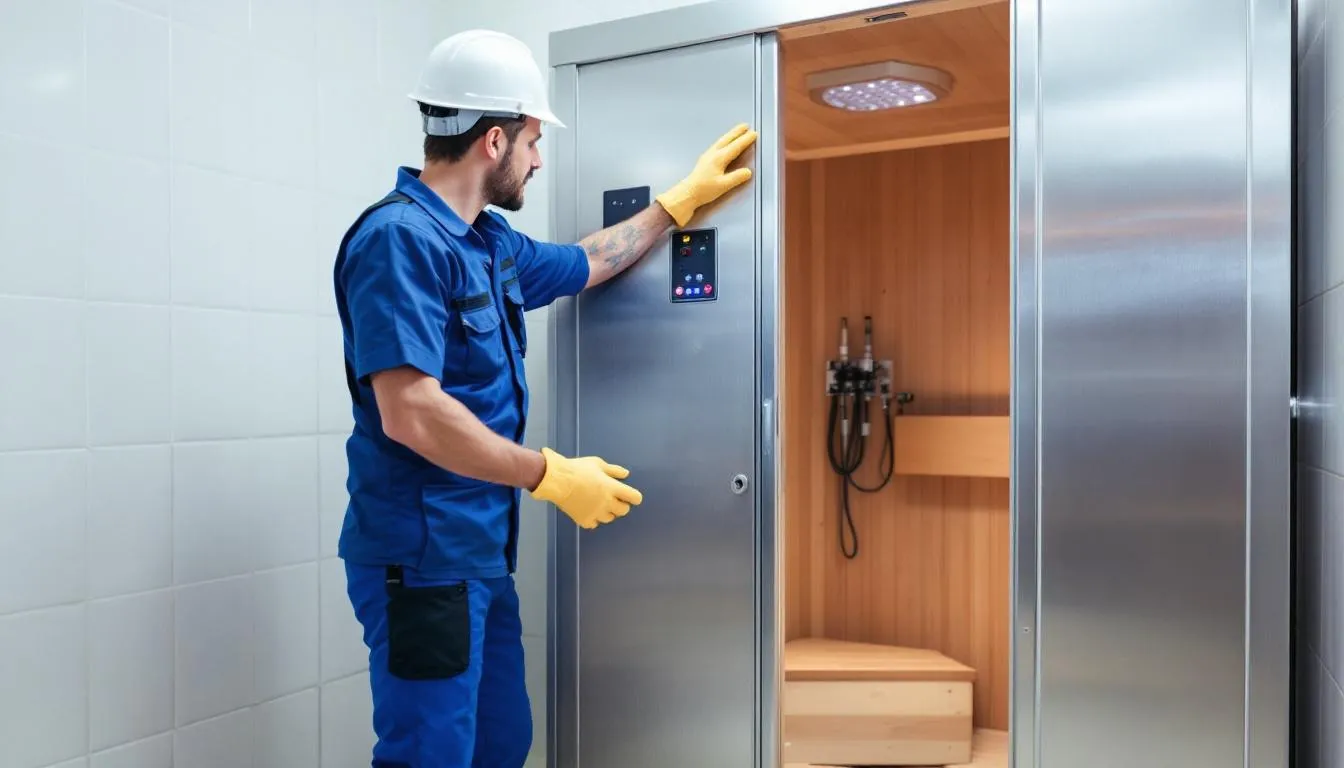
Regular inspection routines can prevent potential sauna issues from escalating. After wiring a sauna heater, it is crucial to test the voltage, test the amperage draw, and test the thermostat function.
Regular maintenance ensures the longevity and safety of your sauna's electrical components. This is true whether you have a full-spectrum infrared sauna for sale model or traditional sauna.
Routine maintenance tasks include checking for wear and tear, heater and control panel functionality, and secure electrical connections in the electrical system. Conduct regular inspections monthly for quick checks and quarterly for comprehensive reviews.
Dedicate an hour to each thorough inspection. Additionally, benches, doors, and other fixtures should be inspected for structural integrity.
Routine Inspections and Maintenance Schedule
Routine maintenance is essential as it ensures safety and effectiveness over time. Conduct regular inspections monthly for quick checks and quarterly for comprehensive reviews.
Inspection should include checking for wear and tear, heater and control panel functionality, and secure electrical connections. These checks play a crucial role in overall safety.
Additionally, benches, doors, and other fixtures should be inspected for structural integrity. Regular inspections ensure that your sauna operates safely and efficiently.
This provides a relaxing and enjoyable experience every time. Proper maintenance maximizes the benefits whether you're enjoying a solo session or sharing the experience in a multi-person unit.
Why Hire a Licensed Electrician for Professional Installation?
Hiring a licensed electrician for your home sauna's electrical installation is non-negotiable. A licensed electrician should handle all electrical installations for saunas to avoid safety risks.
They ensure that the sauna's electrical setup is safe, efficient, and compliant with local electrical codes. This not only protects your investment but also ensures the safety of your home and family.
Licensed electricians have the expertise to manage the complex electrical requirements of a sauna. They can correctly size the electrical panel, select the appropriate wiring, and install necessary protective devices like GFCI outlets.
Consult a certified electrician before installing any outlet for your sauna. This ensures that your sauna's electrical system can handle the additional load and operate safely.
Before activating power, a licensed electrician should inspect the sauna electrical setup. This final check ensures that all components are correctly installed and functioning as intended.
By hiring a professional, you can enjoy your sauna with peace of mind, knowing that every detail has been meticulously handled. This is especially important when investing in a luxury home sauna where quality and safety are paramount.
Ensuring Code Compliance and Safety Standards
Adhering to local electricity codes is crucial for preventing hazards such as fire risks and equipment malfunction. The sauna installation guide covers essentials of electric sauna installation and required power components.
The importance of hiring a licensed electrician cannot be overstated. Regular electrical maintenance and professional assistance are crucial for ensuring the longevity and safety of a sauna's electrical components.
Ensuring code compliance not only guarantees safety but also enhances the well-being of sauna users. By creating a safe and efficient electrical setup, you can enjoy the full benefits of your sauna without worrying about potential hazards.
Compliance with local codes ensures that your sauna operates smoothly and safely for years to come. This applies whether you're considering an outdoor full-spectrum infrared sauna or indoor installation.
Looking for professional installation support? Contact our team to discuss your sauna options and electrical requirements.
Summary
In summary, setting up a home sauna involves careful planning and adherence to electrical requirements. From understanding voltage and amperage needs to selecting the right heater and ensuring proper wiring, each step is crucial.
Regular maintenance and professional installation further enhance safety and efficiency. This allows you to relax and enjoy your sauna with confidence.
By following these guidelines, you can create a home sauna that not only meets your needs but also provides a luxurious and safe retreat. Remember, investing in proper electrical setup and maintenance is essential for longevity and performance.
So, take the time to plan, consult professionals, and enjoy the many benefits of a well-designed home sauna.
Visit HomeSauna.com today to explore our complete collection and start your journey to the perfect home sauna experience.
Frequently Asked Questions About Home Sauna Electrical Requirements
What Voltage and Amperage Are Required for Home Sauna Installation?
A home sauna installation typically requires a 240-volt power supply with a circuit breaker size ranging from 30 to 60 amps. This voltage is standard for high-power appliances and ensures optimal performance and safety during use.
The specific amperage requirement depends on your heater's kilowatt rating. Larger heaters for bigger saunas will require higher amperage.
Consulting a licensed electrician is essential to determine the exact requirements for your specific setup. They ensure your electrical panel can handle the load safely.
Why Is a Dedicated Circuit Necessary for a Sauna Heater?
A dedicated circuit is necessary for a sauna heater to ensure safe operation and prevent overloading other electrical systems in your home. This arrangement reduces the risk of electrical fires.
This dedicated circuit provides the heater with its own breaker and wiring, separate from other household circuits. This guarantees optimal performance of the sauna heater while protecting your home's electrical system.
All professional home infrared sauna installation projects require dedicated circuits to meet safety codes. This ensures reliable operation for years to come.
How Do I Choose the Right Size Sauna Heater?
To choose the right size sauna heater, allocate 1 kilowatt (KW) of power for every 50 cubic feet of sauna space. For example, a 200 cubic foot sauna requires a 4 KW heater.
If the sauna is outdoor and uninsulated, increase the power by 25-30% to compensate for heat loss. Proper sizing is crucial whether you're installing the best infrared sauna for home or traditional model.
Consider your sauna's dimensions, insulation quality, and personal temperature preferences when making your selection. Undersized heaters struggle to reach desired temperatures while oversized heaters waste energy.
Are Home Saunas Safe for Health with Proper Electrical Setup?
Yes, home saunas are safe for health when properly installed with correct electrical requirements. A properly wired sauna with appropriate voltage, amperage, dedicated circuits, and GFCI protection ensures both electrical safety and optimal health benefits.
The key is working with licensed electricians who understand sauna-specific requirements and local electrical codes. Proper electrical setup prevents hazards like electrical fires, shocks, and equipment malfunction.
This allows you to safely enjoy infrared sauna health benefits like improved circulation, stress relief, and detoxification. Regular maintenance of electrical components further enhances safety and longevity.
What Type of Lighting Is Best for Saunas?
LED lights are the best choice for saunas because they generate minimal heat and are moisture-resistant. They create a pleasant atmosphere while ensuring safety in high-temperature environments.
LED lights have water-resistant properties that make them ideal for the humid sauna environment. Their low heat output prevents additional temperature increases in an already hot space.
They're also energy-efficient with long lifespans, reducing maintenance needs. When selecting LED lights for your sauna, ensure they're specifically rated for high-temperature and high-humidity environments.
Why Should I Hire a Licensed Electrician for My Sauna Installation?
Hiring a licensed electrician for your home sauna installation is essential to ensure safety and compliance with local electrical codes. Licensed electricians have specialized knowledge of sauna electrical requirements.
They understand proper wire sizing, dedicated circuit installation, GFCI protection, and code compliance. They can accurately assess your home's electrical capacity and make necessary upgrades.
This professional expertise protects your investment and safeguards the well-being of your home and family. DIY electrical work on saunas is strongly discouraged due to serious safety risks.
What Is the Difference Between Infrared Sauna Vs Traditional Sauna Electrical Requirements?
The infrared sauna vs traditional sauna electrical requirements differ primarily in power consumption and heating methods. Traditional saunas typically require higher wattage heaters (6-10 KW) to heat the air and rocks to high temperatures.
Meanwhile, infrared saunas are more energy-efficient, using lower wattage heaters (1.6-3 KW) that directly heat the body. Both types still require 240-volt circuits, but infrared saunas generally need lower amperage breakers.
Infrared models heat up faster and consume less energy overall. This makes them attractive for those concerned about operating costs. Both require dedicated circuits and professional installation for safety.
Which Is Better: Indoor or Outdoor Sauna?
The choice between indoor or outdoor sauna depends on your space, budget, and preferences. Indoor saunas offer convenience, year-round accessibility, and easier climate control, making them ideal for consistent use.
Outdoor infrared sauna models provide a natural setting, more ventilation options, and don't take up interior space. Consider factors like installation complexity, weatherproofing needs, and maintenance requirements.
Indoor saunas typically have simpler ventilation needs. Meanwhile, outdoor models may benefit from natural airflow but require weather-resistant construction. Both can provide excellent wellness benefits with proper installation and ventilation.
What Are the Best Home Sauna Brands for 2025?
The best home sauna brands 2025 offer advanced electrical systems with energy-efficient heaters, smart control panels, and comprehensive safety features. Top brands provide detailed electrical specifications and UL-listed components.
Look for brands that offer both traditional and infrared options with proper voltage requirements and dedicated circuit compatibility. The best manufacturers provide clear electrical documentation and warranty coverage for electrical components.
Quality brands ensure their saunas meet or exceed local electrical codes. They include features like GFCI protection, digital controls, and energy-efficient LED lighting systems. Professional installation support is also a key differentiator.
How Often Should Sauna Electrical Components Be Inspected?
Sauna electrical components should be inspected monthly for quick checks and quarterly for comprehensive reviews. Monthly inspections should verify that control panels function properly and lights operate correctly.
Check for visible signs of wear or damage to wiring. Quarterly comprehensive inspections should include testing voltage and amperage.
Check all electrical connections for tightness and corrosion. Verify GFCI function and examine the heater for any issues. Annual professional inspections by a licensed electrician are recommended to ensure continued code compliance.
What Electrical Upgrades Might Be Needed for Home Sauna Installation?
Home sauna installation often requires electrical upgrades including a new dedicated 240-volt circuit. An electrical panel upgrade may be needed if current capacity is insufficient.
Installation of appropriate circuit breakers (30-60 amp depending on heater size) is essential. Proper gauge wiring from panel to sauna location and GFCI protection for wet locations are also required.
Some homes, especially older ones, may need complete electrical panel replacement to accommodate the additional load. Your licensed electrician will assess your current electrical system and recommend necessary upgrades.
How Often Should You Use an Infrared Sauna?
For optimal health benefits, most people can safely use an infrared sauna 3-4 times per week for 20-30 minutes per session. Beginners should start with shorter sessions of 10-15 minutes.
Gradually increase duration as your body adapts. Proper ventilation and electrical setup during each session are crucial to maintain air quality.
This maximizes the infrared sauna benefits detox capabilities. Athletes seeking specific therapeutic benefits may use infrared saunas more frequently, even daily, but should ensure adequate hydration.
What Are the Most Popular Infrared Saunas for Home Use?
The most popular infrared saunas for home use feature reliable electrical systems, energy-efficient operation, and user-friendly controls. Popular models include both 1-person and 2-person configurations.
They offer full-spectrum or far-infrared heating technology. Top choices have proper electrical specifications with 240-volt compatibility and reasonable power consumption.
Look for models with clear installation instructions, UL-listed electrical components, and good warranty coverage. The best options balance initial cost with long-term operating efficiency and include safety features like automatic shut-off timers.
